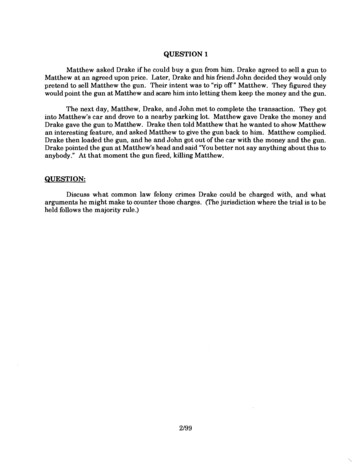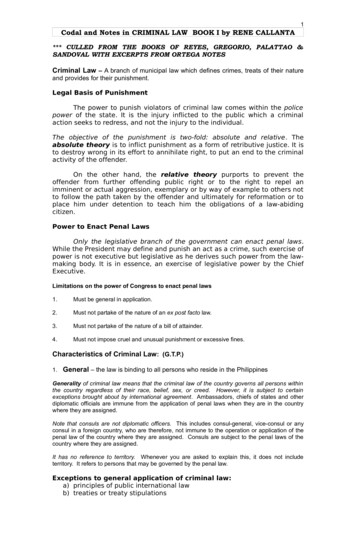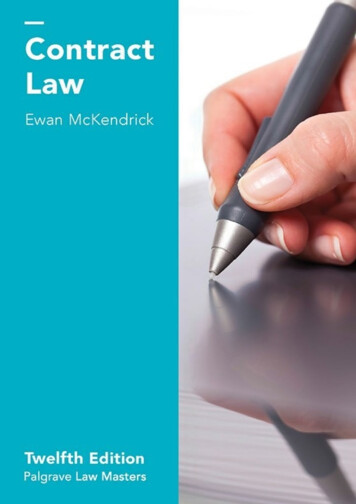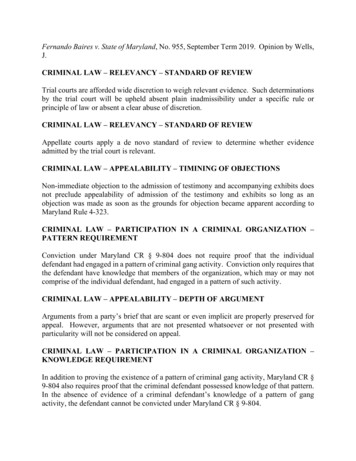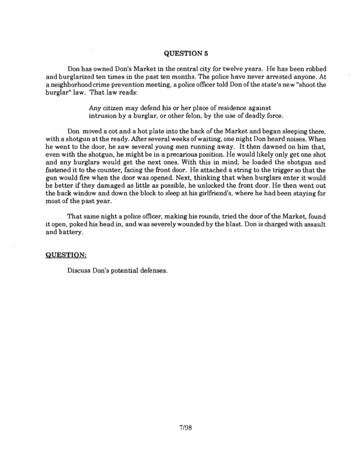
Transcription
QUESTION 5Don has owned Don's Market in the central city for twelve years. He has been robbedand burglarized ten times in the past ten months. The police have never arrested anyone. Ata neighborhood crime prevention meeting, apolice officer told Don of the state's new "shoot theburglar" law. That law reads:Any citizen may defend his or her place of residence againstintrusion by a burglar, or other felon, by the use of deadly force.Don moved a cot and a hot plate into the back of the Market and began sleeping there,with a shotgun a t the ready. After several weeks of waiting, one night Don heard noises. Whenhe went to the door, he saw several young men running away. It then dawned on him that,even with the shotgun, he might be in a precarious position. He would likely only get one shotand any burglars would get the next ones. With this in mind, he loaded the shotgun andfastened it to the counter, facing the front door. He attached a string to the trigger so that thegun would fire when the door was opened. Next, thinking that when burglars enter it wouldbe better if they damaged as little as possible, he unlocked the front door. He then went outthe back window and down the block to sleep at his girlfriend's, where he had been staying formost of the past year.That same night a police officer, making his rounds, tried the door of the Market, foundit open, poked his head in, and was severely wounded by the blast. Don is charged with assaultand battery.QUESTION:Discuss Don's potential defenses.
DISCUSSION FOR QUESTION 5Don lacked the mens rea for Assault Criminal assault includes both a specificintent to commit a battery, and a battery that is otherwise unprivileged committed withonly general intent. Perkins and Boyce, Criminal Law, 2d ed, Foundation Press a t 173. AsDon intended the act, he had the necessary mind set for assault unless his act wasotherwise excused. If Don committed an unprivileged assault on his victim, the fact that hisvictim turned out to be a police officer is not a defense to the charge of Assault. See Statesv. Feola, 420 U.S. 671 (1975).1.I .Defense of Self and of P r o e r t v All jurisdictions excuse the use of deadly force2.in the reasonable apprehension of imminent and serious bodily harm. & Perkins sunra a t1113. Since Don was not on the premises defendmg himself a t the time of the shooting,however, harm to himself was not imminent.At common law and in the majority of jurischctions, defense of property does not excusedeadly force unless there is an imminent risk to the person. Perkins s w r a a t 1115. Once again,no such risk appears here.3. "Shoot the Burglar" Defense. This applicability of this defense hinges on both amistake of fact -- that a burglar would be shot -- and a mistake of law -- that the grocerywas his residence.c.d.Mistake of fact. Don believed the intrGder would be a burglar. Had it been a burglar,his act would arguably have been privileged under the shoot-the-burglar statute.Whether it would or would not have been so privileged, however, the mistake of factdefense generally requires a n objectively reasonable belief in the fact mistaken. Perkinsand Boyce, sunra a t 1046. The MPC makes an exception where the mistake negatesmens rea; MPC 2.04; this exception is not applicable here, see Answer 1, above. If thetrier of fact finds Don unreasonable in his belief that a burglar would be shot, thisdefense is unavailable. If on the other hand Don is found reasonable in his belief, it onlyavails him if in fact he also qualified under the shoot-the-burglar statute.Mistake of Law. The shoot-the-burglar statute enables a citizen to defend his or her"residence." If Don's grocery, under these facts, was his residence, then this defensemight work. If it was not, however, (he had been, under the facts, living elsewhere withhis girlfriend), although Don reasonably believed it was, his mistake was one of law. Atcommon law and in the majority of jurisdictions, a mistake of law will not releive oneof criminal liability. Perkins, sunra a t 1029. Don may argue an exception here,however. The Model Penal Code provides for a mistake of law when made in reasonablereliance upon an official, if erroneous statement of law made by a public officer chargedwith its enforcement, Model Penal Code Sec. 2.04(3)@),in Don's case the police officer.This defense is doubtful, however, because, under the facts given, although the officerinformed Don of the shoot-the-burglar statute, there is no evidence the officer saidanything to Don about his residence.
Examine #Final ScoreSCORESHEET FOR QUESTION 5ASSIGN ONE POINT FOR EACH STATEMENT BELOWSCORE SHEETDefinition of assault: attempted battery or conduct placinganother in fear of imminent bodily harm.Definition of battery: offensive contact.Recognition that lack of mens rea could amount to a defenseD. had mens rea for the offensesRecognition that defense of property might applyApplication: defense of property does not excusedeadly forceRecognition of mistake of fact.As to specific intent crimes, D's mistake need not havebeen reasonableAs to general intent crimes, D's mistake must have beenreasonable.Recognition of mistake of law.Recognition of exception to Mistake of Law:reasonable reliance on official statementRecognition that elements of assault are not met here.
QUESTION 1Matthew asked Drake if he could buy a gun from him. Drake agreed to sell a gun toMatthew at an agreed upon price. Later, Drake and his friend John decided they would onlypretend to sell Matthew the gun. Their intent was to "rip off" Matthew. They figured theywould point the gun at Matthew and scare him into letting them keep the money and the gun.The next day, Matthew, Drake, and John met to complete the transaction. They gotinto Matthew's car and drove to a nearby parking lot. Matthew gave Drake the money andDrake gave the gun to Matthew. Drake then told Matthew that he wanted to show Matthewan interesting feature, and asked Matthew to give the gun back to him. Matthew complied.Drake then loaded the gun, and he and John got out of the car with the money and the gun.Drake pointed the gun at Matthew's head and said 'You better not say anything about this toanybody." At that moment the gun fired, killing Matthew.QUESTION:Discuss what common law felony crimes Drake could be charged with, and whatarguments he might make to counter those charges. (The jurisdiction where the trial is to beheld follows the majority rule.)
DISCUSSION FOR QUESTION 1Drake could be charged with the following common law felonies: conspiracy tocommit robbery, robbery, felony murder, and murder. With respect to the murder charge,Drake might more appropriately be convicted of the lesser included offense of manslaughter.If convicted of all crimes charged, the murder or manslaughter and robbery convictions wouldmerge into the felony murder conviction. The conspiracy conviction would not merge into therobbery or felony murder convictions.The elements of conspiracy are: (1) an agreement between two or more people,(2) with the specific intent to enter an agreement, and (3) with the specific intent to commita crime. The majority rule is that the conspirators must also commit an overt act infurtherance of the conspiracy. Wharton's Criminal Law (15th Edition), 8 678-684.Here, Drake and John expressly agreed to sell Matthew a gun and then to retain boththe money and the gun. The day after they entered into their agreement, they acted on theirplan, thus committing overt acts in furtherance of the conspiracy.RobbersThe elements of robbery are: a taking of the property of another person from his personor in his presence by force or intimidation and without his consent with the intent topermanently deprive the victim of the property. The threats must be of immediate death orserious physical injury to the victim, and must be made either before or immehately aftertaking the property. Wharton's Criminal Law (15th Edition), 55 454, 455, 457-63.Here, after selling Matthew a gun and accepting his money, the gun became Matthew'sproperty. Drake took the gun back with the intent to permanently deprive Matthew of the gun(contrary to his representation that he only wanted to show Matthew a feature of the gun,Drake never intended to give the gun back to Matthew). And, although Matthew gave the gunback to Drake when Drake said he wanted to show Matthew a feature of the gun, Matthew didnot consent to letting Drake keep the gun permanently. Drake took the gun from Matthew'sperson, and pointed the gun a t his head while cautioning him not to say anything, thussatisfying the requirement that the property be taken by force or threat.Some examinees might argue that Drake is guilty of larceny rather than robbery. Theelements of larceny are: the taking and carrying away (asportation) of the property of anotherwithout the victim's consent and with the intent to permanently deprive him of the property.The primary difference between larceny and robbery is that robbery involves the use of forceor threats, while larceny does not. Here, Drake clearly used threats to steal the gun, so isguilty of robbery.
DISCUSSION FOR QUESTION 1Page TwoFelonv MurderIf a killing is committed in the course of committing a felony, it is felony murder. Themajority rule is that a robbery can serve as a predicate offense for felony murder. To obtaina conviction for felony murder, the prosecution is required to show only that a person waskilled during the commission of a felony, and that the victim was not a participant in thecrime. The majority rule is that the death must have been a foreseeable result of commissionof the felony. Wharton's Criminal Law (15th Edition), QQ 147, 149, 150.Here, if Drake is convicted of the underlying felony (robbery), he should also beconvicted of felony murder. Matthew was killed during the course of the robbery, and it wasforeseeable that he would be killed when Drake pointed the loaded gun a t his head.MurderIf Drake were acquitted of the robbery charge, he could not be convicted of felonymurder. Thus, the prosecution should separately charge him with murder.Murder is the unlawful killing of a human being with malice aforethought. Wharton'sCriminal Law (15th Edition), QQ 114 and 139; Model Penal Code, Q 2 10.2.In the absence of facts excusing the homicide or reducing it to voluntary manslaughter,malice aforethought exists if the defendant has the intent to kill, or the intent to inflict greatbodily injury, or if he acts with reckless indifference to an unjustifiably high risk to human life.Wharton's Criminal Law (15th Edition), Q 139. Intentional use of a deadly weapon gives riseto a permissive inference of intent to kill. Wilson v. State, 832 S.W.2d 777 vex. App. 1992);seealso Wharton's Criminal Law (15th Edition), Q 141.-Nevertheless, here, Drake did not specifically intend to kill Matthew, and probably didnot even intend to cause him serious bodily harm. However, Drake probably acted recklessly.A person acts recklessly when he consciously disregards a substantial or unjustifiable risk thata certain result will follow, and this disregard constitutes a gross deviation fiom the standardof care that a reasonable person would use under similar circumstances. Wharton's CriminalLaw (15th Edition), Q 145. By pointing a loaded gun at Matthew's head, even if just to scarehim, Drake arguably knew of and consciously hsregarded the risk that Matthew would beshot.ManslaughterThe prosecution should charge Drake with murder, but the jury might find him guiltyof the lesser offense of involuntary manslaughter. Involuntary manslaughter is the criminallynegligent killing of another person. A person is criminal negligent when he fails to be awareof a substantial and unjustifiable risk that a result will follow, and such failure constitutes asubstantial deviation from the standard of care that a reasonable person
DISCUSSION FOR QUESTION 1Page Threewould exercise under the circumstances. To determine whether a person acted negligently, anobjective standard is used. Here, a t the very least, by pointing a loaded gun a t Matthew'shead, Drake ignored the substantial risk that Matthew would be shot. 2 Wharton's CriminalLaw (15th Edition), 99 168, 169, 171.-Lesser included offenses merge into greater offenses. A lesser included offense is onethat consists entirely of some, but not all, elements of the greater crime.Here, if Drake were convicted of all crimes charged (conspiracy to commit robbery,robbery, felony murder, and murder or manslaughter), some of his convictions would merge.Specifically, because the robbery was the underlying felony for the felony murder conviction,i t is a lesser included offense of felony murder, and would merge into the felony murderconviction.Boulies v. People, 770 P.2d 1274 (Colo. 1989).Moreover, a criminal defendant cannot be convicted of two murder-related chargesinvolving the same victim.People v. Hickham, 684 P.2d 228 (Colo. 1984). In addition,murder and manslaughter are lesser included offenses of felony murder. Thus, if Drake wereconvicted of either murder or manslaughter in addition to felony murder, the murder ormanslaughter conviction would merge into the felony murder conviction.People v.Hickham, suma.Conspiracy does not merge with the completed offense. Thus, conspiracy convictionwould not merge into either the felony murder or robbery convictions.
Seatscore)I(Please use blue or black Denand write numbers clearly1.Recognition of Conspiracy Issuela.2.Recognition of Larceny Issue2a.3.6.Attempted battery or intentional creation of reasonable fear ofimminent bodily harm.Recognition of Murder Issue5a.Kdling of another with malice aforethought.5b.Malice aforethought can be established by intent to kill, intentto seriously injure, depraved heart, or felony murder.Recognition of Involuntary Manslaughter Issue6a.7.Taking property from the presence of another by force orintimidation and with intent to permanently deprive.Recognition of Assault Issue4a.5.Wrongful taking and carrying away of another's propertywith intent to permanently deprive .2.2a.Recognition of Robbery Issue3a.4.An agreement between two or more people with theintent to commit a crime requiring overt act.Kdling of another with criminal negligence.Recognition of Merger Issue3a.4.4a.5.5b.
QUESTION 2Darrell picked up his eight year old daughter, Kate, at school on Friday afternoorWhile they were riding home, she told him that her grandfather, Victor, had molested her simonths earlier. Darrell's relationship with Victor was already estranged; they had not spokefor over a year.The following Monday night, Darrell went to Victor's house, entered through the bacdoor, and shot Victor in the chest, killing him.QUESTION:Discuss potential. crimes with which Darrell may be charged and possible defenses hmay raise.
DISCUSSION FOR QUESTION 21. Possible C r i m e sDarrell potentially is guilty of either murder or manslaughter, and burglary.A.MurderElements of CrimeMurder is the unlawful killing of a human being with malice aforethought. 2Wharton's Criminal Law (15th Edition), 5 114 and 139; Model Penal Code, 5 210.2.In the absence of facts excusing the homicide or reducing it to voluntarymanslaughter, malice aforethought exists if the defendant has the intent to kill, or theintent to inflict great bodily injury. 2 Wharton's Criminal Law (15th Edition), 5 139.Intentional use of a deadly weapon gives rise to a permissive inference of intent to kill.Wilson v. State, 832 S.W.2d 777 Vex. App. 1992); Peonle v. Muldrow, 332 N.E.2d 664 (Ill.App. 1975); see also 2 Wharton's Criminal Law (15th Edition), 5 141.Here, unless Darrell acted under a sudden heat of passion & Section B, infra), thestate should be able to prove the elements of murder without difficulty. Darrell killedVictor, another human being. When Darrell fired the gun (a deadly weapon) a t Victim, themost reasonable assumption under these circumstances is that he intended to kill Victor, ora t least cause serious bodily injury to him. Thus, he acted with the requisite maliceaforethought.B.ManslaughterA killing that otherwise constitutes murder is mitigated to voluntary manslaughtera t common law if it occurs in a "sudden heat of passion." The elements of the provocationmitigator are: (1) the provocation must have been one that would arouse sudden andintense passion in the mind of an ordinary person, such as to cause him to lose his selfcontrol; (2) the defendant must have in fact been provoked by the victim; and (3) there mustnot have been a sufficient time between the provocation and the killing for the passions of areasonable person to cool off. With respect to the third element, the provocation need notoccur immediately before the act causing death, and the fact finder should consider theparticular emotional state of the defendant, the nature of the provocation, and theattendant circumstances. Coston v. Peonle, 633 P.2d 470 (Colo. 1981); Peoi lev. Wadlev,890 P.2d 151 (Colo. App. 1994); see also 2 Wharton's Criminal Law 45 155-57, 166; ModelPenal Code, 8 210.3(1)@).Here, Darrell learned that Victor had molested Kate. This probably constitutes asufficiently provoking act to arouse a sudden and intense passion in the mind of anordinary person such a s to cause him to lose his self-control. Thus, the first two elements ofthe offense will probably be met.
DISCUSSION FOR QUESTION 2Page TwoWhether the three-day delay between the time Darrell learned of the molestationand the time he killed Victor was a suficient interval to allow a reasonable person tofunction rationally after having been severely provoked is a more difficult question, thoughthe answer is probably yes.At common law, the elements of burglary are an unlawful breaking and entry into adwelling of another person a t night with the intent to commit a felony therein. UnitedStates v. Brandenburg, 144 F.2d 656 (3rd Cir. 1944); Sanchez v. P e o l e ,142 Colo. 58, 349P.2d 561 (1960); see also 3 Wharton's Criminal Law 55 316-19, 328; Model Penal Code, 8221.1. A "breaking" requires only minimal force, and it is enough if the defendant merelyopens a closed but unlocked door. United States v. Evans, 415 F.2d 340 (5th Cir. 1969); seealso 3 Wharton's Criminal Law, 15th Edition) 8318. Because Darrell's relationship withVictor was already estranged, and the two men had not spoken for over a year, we canassume t h a t Darrell did not have Victor's consent to enter his house. Darrell's entry intoVictor's house on Monday night satisfies the requirement of an unlawful breaking andentry into the dwelling of another a t night.Darrell might claim that, when he entered Victor's house, he did not intend to killVictor, but only to confront him about his having molested Kate. The fact that Darrell hada gun, however, suggests t h a t he a t least intended to commit assault by using the gun tothreaten Victor with serious bodily harm, if not to kill him. Moreover, if a felony is actuallycommitted, the fact-finder may infer that the defendant intended to commit the felony a tthe time of the breaking and entry. Davis v. State, 165 So.2d 918 (Ala. App. 1969); State v.Rood, 462 P.2d 399 (Ariz. App. 1969); 3 Wharton's Criminal Law (15th Edition), 8 328.Thus, Darrell will probably be found guilty of burglary.2.Possible DefensesThere are no defenses (other than denial of the elements of the charged offenses)available to Darrell. Darrell, however, might seek to defend the murderimanslaughtercharge by asserting the defense-of-another defense. More specifically, he might claim thathe was acting to protect Kate from Victor. Under the defense-of-another defense, a person isjustified in using deadly force to protect another person from a n imminent unlawful deadlyattack. However, a defendant h a s the defense of defense of others only if he reasonablybelieved or it reasonably appeared to him that the person he assisted had the legal right touse force in her own defense. A person may use deadly force in self-defense if she is: (1)without fault, (2) confronted with unlawful force, and (3) threatened with imminent deathor great bodily harm. A person may not use deadly force to defend herself if harm is merelythreatened a t a future time. Peonle v. Hawthorne, 190 Colo. 437, 548 P.2d 124 (1976); see,&a2 Wharton's Criminal Law (15th Edition), 8127 and 130; Model Penal Code, 553.04and 3.05.
DISCUSSION FOR QUESTION 2Page ThreeHere, the molestation took place six months earlier, and there is no indication that itwas life threatening or that it could have caused great bodily harm. Because Victor did notthreaten Kate with death or great bodily harm immediately before Darrell shot him,Darrell will not be able to rely on the defense-of-another defense.
SeatmPlease use blue or black penand write numbers clearlyMurder - the killing with "malice aforethought," of anotherhuman being.1.Malice aforethought -- 1) intent to kill, 2) intent to cause greatbodily injury, 3) "depraved and malignant heart," 4) intent tocommit another felony.2.Facts support intent to kill or cause great bodily injury.3.Killing during the course of burglary amounts to felony murder.4.Manslaughter-- the intentional killing, with provocation, of another.5.Manslaughter established where provocation sufficient to cause sudden6.and intense passion;subjective and objective provocation; and7.no cooling off period.8.--Burglary unlawful breaking and entering into the dwelling ofanother at night with intent to commit felony therein.Consideration of defense of others.9.
QUESTION 2One evening while sitting in a bar, after having had a few drinks, Carriethought of a way to get some fast cash. She stumbled from the bar to Valerie's house.The house appeared to be empty, so she went to the back door, found it unlocked andwent inside where she grabbed some jewelry and cash. Then, in a n attempt to coverup her crime, she poured gasoline around the house, lit a fire, and ran. Unbeknownstto Carrie, Valerie was sleeping inside the house and died in the fire.QUESTION:Discuss crimes Carrie may have committed and any defenses to her actions.(Carrie lives in a jurisdiction that follows traditional common law principles.)
DISCUSSION FOR QUESTION 2BurglarsIAs an initial matter, Carrie is guilty of the crime of burglary. At common law,burglary is defined as the breaking and entering into the dwelling house of another inthe nighttime with the intent to commit a felony therein. Oken v. State, 327 Md. 628,612 A.2d 258 (1992). Unlawful entry into a building in which an individual is notauthorized or invited to enter constitutes an unlawful entry. State v. Howe, 116 Wash.2d 466,805 P.2d 806 (1991). Moreover, even where that entry is through an unlockeddoor, that act is sufficient to constitute a breaking for purposes of sustaining aburglary conviction. I& A "dwelling house" is defined as a building, which isregularly used as a place to sleep. A building does not become a "dwelling" by reasonof the fact that someone may sleep there on rare occasion. Poff v. State, 4 Md. App.186,241A.2d 898 (1968).LarcenyThe intent to commit the larceny is evident from the fact pattern and, therefore,all of the necessary elements to establish the crime of burglary are present. The crimeof larceny is the taking and carrying away of the personal property of another with theintent to unlawfully and permanently deprive the owner of its use. Swift v. AmericanUniversal Insurance Comoanv, 349 Mass. 637, 212 N.E.2d 448 (1965). The facts asgiven clearly establish that Carrie has committed the crime of larceny.ArsonIn order to establish the crime of arson, the Defendant must be shown to havemaliciously and willfully burned the dwelling house of another. State v. Oxendine, 305NC 126,286 S.E.2d 546 (1982). Arson is a crime of general intent and is therefore notsubject to the defense of diminished capacity. Veverka v. Cash, 3 18 N.W.2d 447 (1982).As is true with the above crimes, the facts clearly establish that Carrie is guilty of thiscrime as well.Felons MurderFelony murder arises where an individual causes the death of another whilecommitting or attempting to commit robbery, rape, arson or burglary. See eneral1.v Conrad v. State, 75 Ohio St. 52. Moreover, where the felony relied upon involves aburglary, it is not necessary to prove the existence of items which could have beenstolen, since it is only necessary to prove an attempt to commit the underlying felony.State v. Davis, 56 Ohio St. 2d 5 1. Again, the above discussion makes clear that Carrieis guilty of the underlying felony of arson since Valerie was killed as a result of thecommission of that felony. Therefore, a claim of felony murder wiU lie against Carrie.
DISCUSSION FOR QUESTION 2Page 2Potential DefenseThe only potential defense that Carrie may raise with regard to the above actsis that she was voluntarily intoxicated and thus unable to intend to commit any of theabove-mentioned crimes. Generally, voluntarily intoxication is not a defense to anycrime. State v. Davis,81 Ohio App. 3d 706, 612 N.E.2d 343 (1992). An exception tothe general rule is that voluntary intoxication may be a defense when specific intentis a necessary element of the charged offense in that the intoxication was significantenough to preclude the formation of such intent. Id. Voluntary intoxication thereforemay be a defense to the specific intent crimes of burglary and larceny. Nevertheless,there would have to be proof that Carrie was so intoxicated as to not be able to formthe requisite intent.
SeatScore-Please use blue or black penand write numbers clearlyRecognize the crime of burglary1.Identify the elements of burglary (breaking andentering into the dwelling house of another atnight with the intent to commit a felony).Even though door was unlocked, Carrie's entry constituted?breaking."3.Recognize the crime of larceny.4.Identify elements of larceny (the taking and carryingaway of the personal property of another with theintent to unlawfully and permanently deprive the ownerof its use).Recognize the crime of arson.Iden* the elements of arson (the malicious burning of thedwelling house of another).Recognize the crime of felony murder.Iden* elements of felony murder (causing of the death of anindividual in the course of a felony).Recognize the potential defense of voluntary intoxication.Recognize that voluntary intoxication applies only to specificintent crimes.
QUESTION 7Dixon was upset that his sister, Pam, was dating Vickers. One afternoon,Dixon went to the shoe store in the local mall where Vickers worked and confrontedhim. Dixon demanded that Vickers stop seeing his sister, and Dixon threatened tobeat Vickers up if he did not agree. In response, Vickers seized Dixon, twisted hisarm behind his back, and forced him out of the shoe store into the parking lot.Vickers told Dixon that he was going to kill him. Then Vickers released his holdand threw Dixon to the ground. Vickers laughed, turned his back and started towalk away. Dixon pulled out a knife, leaped up, and stabbed Vickers twice in theback, killing him.Discuss the common law crimes Dixon may face, and any defense that may beavailable.
DISCUSSION FOR QUESTION 7MurderThe defendant may be guilty of murder. Murder at common law is theunlawful killing of another human being with malice aforethought. Theprosecution must prove beyond a reasonable doubt both that the defendant causeddeath and that he had malice. See generally 4 W. Blackstone, Commentaries on theLaws of England * 195, 198 (T. Cooley ed. 1884), Joshua Dressler, UnderstandingCriminal Law 467 (2d ed. 1995), W. LaFave & A. Scott, Criminal Law 611 (2d ed.1986).Malice may be established by a) intent to kill (i.e., purpose or knowledgedeath will result), b) intent to inflict serious bodily injury (i.e., a grave injury thatimpairs health seriously), Commonwealth v. Dorazio, 365 Pa. 291, 74 A.2d 125(1950), Dressler, supra, at 475-76, c) extremely reckless conduct that evidences "adepraved heart regardless of human life," 4 Blackstone, supra, 199-200;Dressler,supra, at 477-78; LaFave & Scott, supra, at 612-25, or d) intent to commit a felony(felony murder).-In this case malice may be proved by Dixon's intent to kill and his intent toinflict serious bodily injury. His intent may be inferred from the natural andprobable results of his act (the stabbing with the knife), see Dressler, supra, at 471,though the jury must not be instructed that such inferences are required.Francis v. Franklin, 471 U.S. 307 (1985)(holding that a jury instruction violateddue process when it told jury to presume defendant intended natural and probableconsequences of his acts but that presumption could be rebutted, because such aninstruction might cause reasonable jurors to conclude that defendant bore burden ofproving his own lack of intent, thus shifting the burden of proof from the state).ManslaughterThe defendant may be guilty of manslaughter. Manslaughter at common lawis the unlawful killing of another human being without malice. See enerallvid.at652; 4 Blackstone, supra, 191. A killing may be unlawful yet without malice in oneof two ways. First, a killing that would otherwise suffice to establish m a h e may befound to be mitigated by circumstances that establish actual and adequateprovocation where the defendant killed in a "heat of passion." (This is voluntarymanslaughter.) Second, a killing that would not satisfy any of the criteria of malicewill, nevertheless, be unlawful and constitute manslaughter where the defendantacted with criminal or culpable negligence in causing the death. (This isinvoluntary manslaughter.) Dressler, suma, at 468; LaFave & Scott, suma, at 652,653.To prove voluntary manslaughter, the state must first prove all the elementsfor murder. But murder will be mitigated (lowered) to manslaughter if Dixon acted
in a "heat of passion" as a result of actual and adequate provocation. Traditionally,the st
Matthew asked Drake if he could buy a gun from him. Drake agreed to sell a gun to Matthew at an agreed upon price. Later, Drake and his friend John decided they would only pretend to sell Matthew the gun. Their intent was to "rip off" Matthew. They figured they would point the gun at Matth


